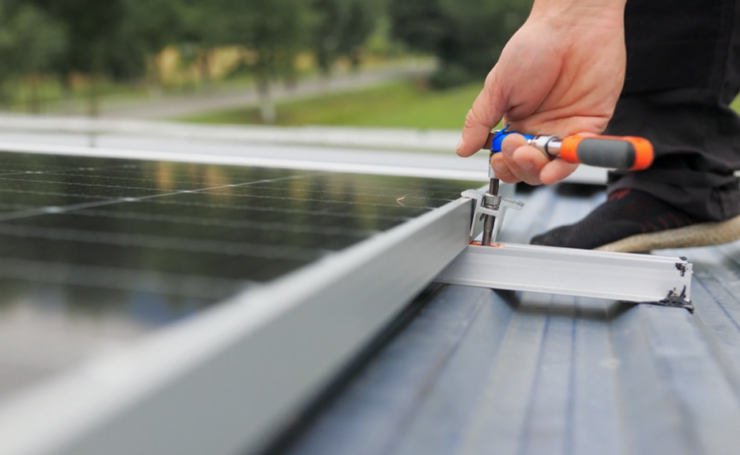Passive solar air heaters are easy to make for people with the necessary know-how. It can be done using downspouts, pop-cans, or roofing sheets, and for a competent DIY expert, it is a pretty straightforward job. Today, we are going to talk about how to make a solar heater and explain the whole process behind it, so read on if you want to find out more about this topic.
You probably know that converting electricity into heat is one of the most expensive uses of energy, and creating a solar heater will definitely cut your electrical bill by the end of the month, for which your pockets will be incredibly grateful. We have a lot to cover regarding this topic, so let us begin without a further redo.
Contents
How to Make a DIY Solar Heater?

Although there are many designs of solar heaters, each and everyone works with the same principle – a small fan feeds the interior air into a south-facing wall-mounted panel. The air gets heated as it passes behind a black surface and then gets returned to the conditioned space at a much higher temperature. So how to make it? Here are several easy ideas on how to make effective DIY solar heaters.
Pop Can Solar Panels
Making a solar panel using pop cans is nothing short of brilliant. However, it is a time-consuming process. All cans that you collect must be cleaned and have holes cut in the bottom. Then, you will need to remove tabs and glue them together in a stack so that you can finally paint them black.
The way these panels work is by air getting blown into the chamber at the bottom, and it gets forced up through the stacks of cans into a top chamber that collects sun-heated air that gets directed back indoors. As we mentioned, making this solar panel is rather time-consuming, but it is every bit effective as any other panel.
Downspout Solar Collectors
Just as the name indicates, this design of the solar panel replaces the stack of pop cans in the solar air heating panel with standard eaves through downspouts painted matt black that absorbs the sun’s rays and generates heat.
It works by the same principle as a pop can solar collector, and although you will likely spend more money on materials, you will save some time and labor, while the panel itself will look much more visually appealing. However, the end result is the same – the air gets heated as it passes through black tubes when the sun shines.
Solar Screen or Sheet Metal Heat Absorber
This design consists of three layers of screen to ensure a unified black surface for generating heat. Screen collectors generally do not separate air into individual chambers like it is the case with the previous two designs; the air rises up a single chamber behind the screen of a flat metal surface.
This design requires a bit more work compared to using sheet metal, which could be made by using old metal roofing, which must be painted matt black. However, the labor will be very much worth it as the screen collector does provide more heat than both designs we have listed above.
How Much Heat Can Solar Heaters Provide?
How much heat you will get from solar heaters largely depends on multiple factors. Here are some aspects that can influence the amount of heat you will get from the DIY solar heater.
Solar Panel Size
The size of the panel ultimately determines the volume of air you can heat up and the output temperature you can get. Choosing the size of the panel you want to build will depend on your needs and how much exterior wall space you can free up for the solar heater panel.
Solar Absorption
Panels can heat up depending on how reflective the black surface is, so it is best to paint it matt paint rather than a glossy one. This glazing will instantly reflect about ten percent on its own.
However, the best you can hope for in overall performance from a solar air heating panel is about eighty percent absorption of available light. It is not ideal, but it gets the job done.

Heat Panel Conductivity
Materials you use in making solar heaters are very important, and you should go for the ones with higher conductivity. These materials will improve the overall performance. For example, a black metal pipe will provide more heat than a black PVC pipe.
Even different metals can provide different conductivity. For instance, copper is an excellent conductor, but it is also very expensive and can be tricky to get in larger sizes or to get paint to adhere to, so the better conductivity might not be worth it when you consider the added cost.
Cloud Coverage
In areas that are regularly overcast, it might not be worth the cost and hassle to either buy or make solar heaters, as you probably will not get enough sun to power them. It is one of the main things that can influence the effectiveness of the solar panel. On the other hand, if you live in an area where there are a lot of sun rays, these solar heaters will definitely be a worthy investment.
The Downside of Solar Heaters

The biggest issue with most renewable energy generators like solar heaters is reliability and energy storage. To put it simply, the wind does not always blow, and the sun does not always shine (or rather, we cannot always see it), and the main drawback is that you only get as much heat as the sun allows you to get.
Short winter days can be very unpredictable in terms of cloud coverage, which makes it very difficult to rely on solar heaters as a primary heat source since you will get all your heat during shiny hours but then will have to go for a much longer period without heat input.
Bottom Line
Although solar heaters can be an excellent source of heat and can be made fairly easily, they are not the most reliable primary heat sources. However, they are an excellent alternative that will save you some money long-term, which is why building your own is a pretty good investment.
We hope you liked our article and that you have found sufficient information to build your own solar heater. Just make sure to consider all the important factors that we have listed and to weigh whether the investment of materials, money, and time will pay off, especially if you live in a region where the sun rarely breaks through clouds.

The outdoors is my playground 24/7, 365. Camping, hiking, mountain biking, grilling and all things related to the planet are my jam.


